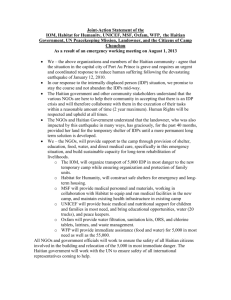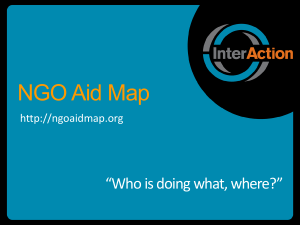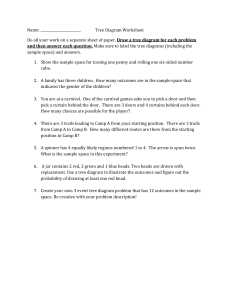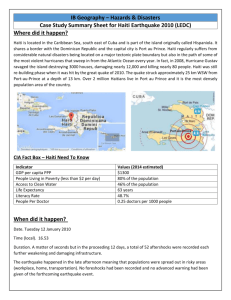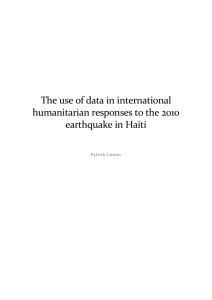Darfur Refugee Simulation
advertisement
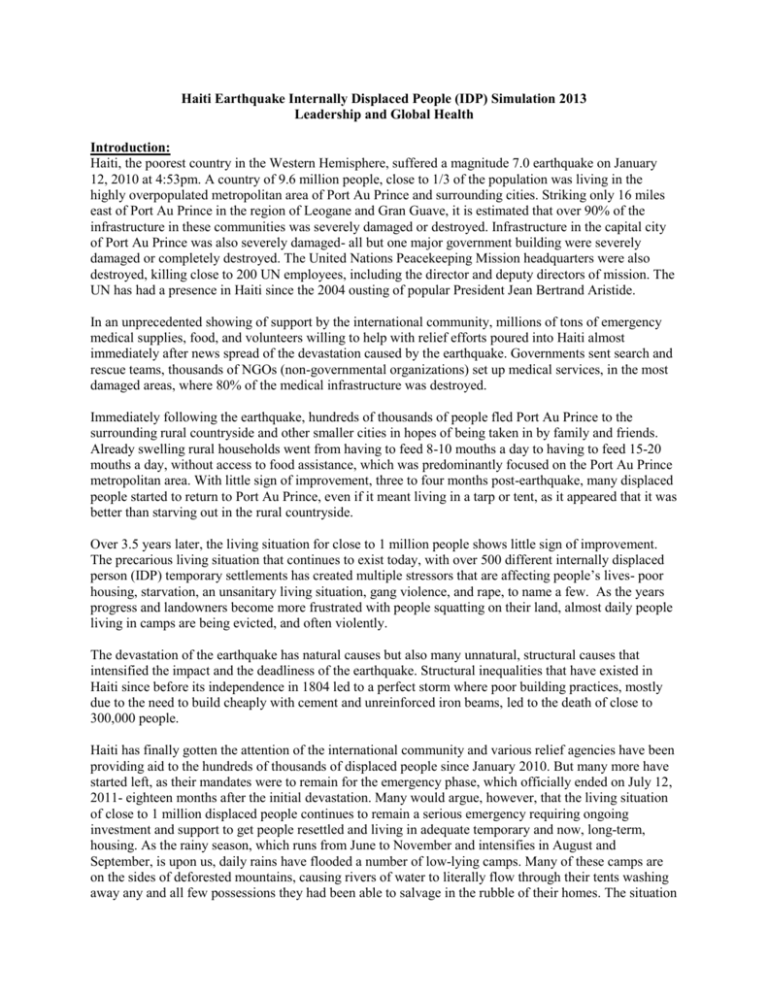
Haiti Earthquake Internally Displaced People (IDP) Simulation 2013 Leadership and Global Health Introduction: Haiti, the poorest country in the Western Hemisphere, suffered a magnitude 7.0 earthquake on January 12, 2010 at 4:53pm. A country of 9.6 million people, close to 1/3 of the population was living in the highly overpopulated metropolitan area of Port Au Prince and surrounding cities. Striking only 16 miles east of Port Au Prince in the region of Leogane and Gran Guave, it is estimated that over 90% of the infrastructure in these communities was severely damaged or destroyed. Infrastructure in the capital city of Port Au Prince was also severely damaged- all but one major government building were severely damaged or completely destroyed. The United Nations Peacekeeping Mission headquarters were also destroyed, killing close to 200 UN employees, including the director and deputy directors of mission. The UN has had a presence in Haiti since the 2004 ousting of popular President Jean Bertrand Aristide. In an unprecedented showing of support by the international community, millions of tons of emergency medical supplies, food, and volunteers willing to help with relief efforts poured into Haiti almost immediately after news spread of the devastation caused by the earthquake. Governments sent search and rescue teams, thousands of NGOs (non-governmental organizations) set up medical services, in the most damaged areas, where 80% of the medical infrastructure was destroyed. Immediately following the earthquake, hundreds of thousands of people fled Port Au Prince to the surrounding rural countryside and other smaller cities in hopes of being taken in by family and friends. Already swelling rural households went from having to feed 8-10 mouths a day to having to feed 15-20 mouths a day, without access to food assistance, which was predominantly focused on the Port Au Prince metropolitan area. With little sign of improvement, three to four months post-earthquake, many displaced people started to return to Port Au Prince, even if it meant living in a tarp or tent, as it appeared that it was better than starving out in the rural countryside. Over 3.5 years later, the living situation for close to 1 million people shows little sign of improvement. The precarious living situation that continues to exist today, with over 500 different internally displaced person (IDP) temporary settlements has created multiple stressors that are affecting people’s lives- poor housing, starvation, an unsanitary living situation, gang violence, and rape, to name a few. As the years progress and landowners become more frustrated with people squatting on their land, almost daily people living in camps are being evicted, and often violently. The devastation of the earthquake has natural causes but also many unnatural, structural causes that intensified the impact and the deadliness of the earthquake. Structural inequalities that have existed in Haiti since before its independence in 1804 led to a perfect storm where poor building practices, mostly due to the need to build cheaply with cement and unreinforced iron beams, led to the death of close to 300,000 people. Haiti has finally gotten the attention of the international community and various relief agencies have been providing aid to the hundreds of thousands of displaced people since January 2010. But many more have started left, as their mandates were to remain for the emergency phase, which officially ended on July 12, 2011- eighteen months after the initial devastation. Many would argue, however, that the living situation of close to 1 million displaced people continues to remain a serious emergency requiring ongoing investment and support to get people resettled and living in adequate temporary and now, long-term, housing. As the rainy season, which runs from June to November and intensifies in August and September, is upon us, daily rains have flooded a number of low-lying camps. Many of these camps are on the sides of deforested mountains, causing rivers of water to literally flow through their tents washing away any and all few possessions they had been able to salvage in the rubble of their homes. The situation is further complicated by the fact that owners of the land where people are currently living are requesting for them to leave so that they can use the land again. One specific settlement, Camp Chouchou, has over 60,000 people, 5,000 of them in need of immediate relocation if they are to survive through the rains and the remaining 55,000 in need of ongoing, water, sanitation, food, and housing needs. So far 100 children have died in the camp of diarrhea-related illness, and hundreds more show signs of moderate to severe malnutrition. The situation in the camp is further complicated by the absence of potable water, the severe shortage of food at the camp, and on-going clashes between the IDP and the landowners of the space they inhabit. As a result of the clashes between some local residents and the IDP, 5,000 people in the camp have been forced to move about 15 miles outside of the city to an isolated, desert-like location where they will be safer, according to local authorities. An outbreak of cholera leading to severe diarrhea and dehydration is quickly spreading throughout the population as they are in the midst of this forced relocation. The situation has gotten even more desperate and a heightened state of emergency has been declared as the number of casualties from cholera and other disease, starvation and communal-violence lead by gangs, will exponentially increase if aid does not arrive within 72 hours. The following aid agencies: UNICEF, Oxfam, WFP, IOM, Habitat for Humanity, and Doctors Without Borders, had been providing varying levels of support to the camp prior to the recent emergency. An alert has been sent to these NGOs requesting that they remobilize their staff to assist the inhabitants of Camp Chouchou TODAY, keeping in mind that the lives of those staff involved on the ground are in constant danger of disease and violence. Reports of kidnappings are not rare and security of staff must be considered at all times. Each NGO has been instructed to develop specific plans with respect to how they will respond to the ongoing crisis to save lives and how they will cooperate with other NGOs and the Haitian government to effectively respond to this crisis. The Haitian Government has specifically requested a joint action statement regarding the coordinated plan of action by the 5 responding NGOs before moving forward. Morning: Your tasks as a group: (75 minutes) 1. Define the key role(s) that your organization is going to play in setting up the new camp and stopping further spread of cholera and other diseases. a. Keep in mind that the landowner where the 60,000 people are currently living is hostile to the fact that 2.5 years later they are still on his land with little signs of an organized plan for resettlement 2. Define who each of you represents in your group (for example, President, Secretary, Operations Manager, Head Physician/Scientist, Finance Minister, Health Policy Advocate, etc) and the specific role each of you is playing in ensuring proper action is taking place during these next 72 hours 3. Determine the specific course of action you will take as a group to prevent further loss of life. a. What supplies will be needed? How will the supplies be delivered and distributed? Who will be responsible for the distribution? 4. How will you evaluate the success or failure of your intervention? 5. What plans do you have for continued prevention initiatives and sustainability of the camp over time? Afternoon : Preparation of presentation Each NGO is required to give a no more than 10 minute presentation (1-2 minutes per person, each group member must speak) outlining the mission of the organization, each group member’s specific role, the plan of action for resettling those whose lives are at most risk due to flooding, mentioning specific supplies needed and timeframe for action, and how each NGO is working within its organization to respond while coordinating with the other NGOs to ensure a comprehensive response. Panel Discussion: Each NGO chooses 1 member to represent them in a panel Q & A period conducted by heads of the local Haitian government. Creation of Joint Action Statement (together as a group)


